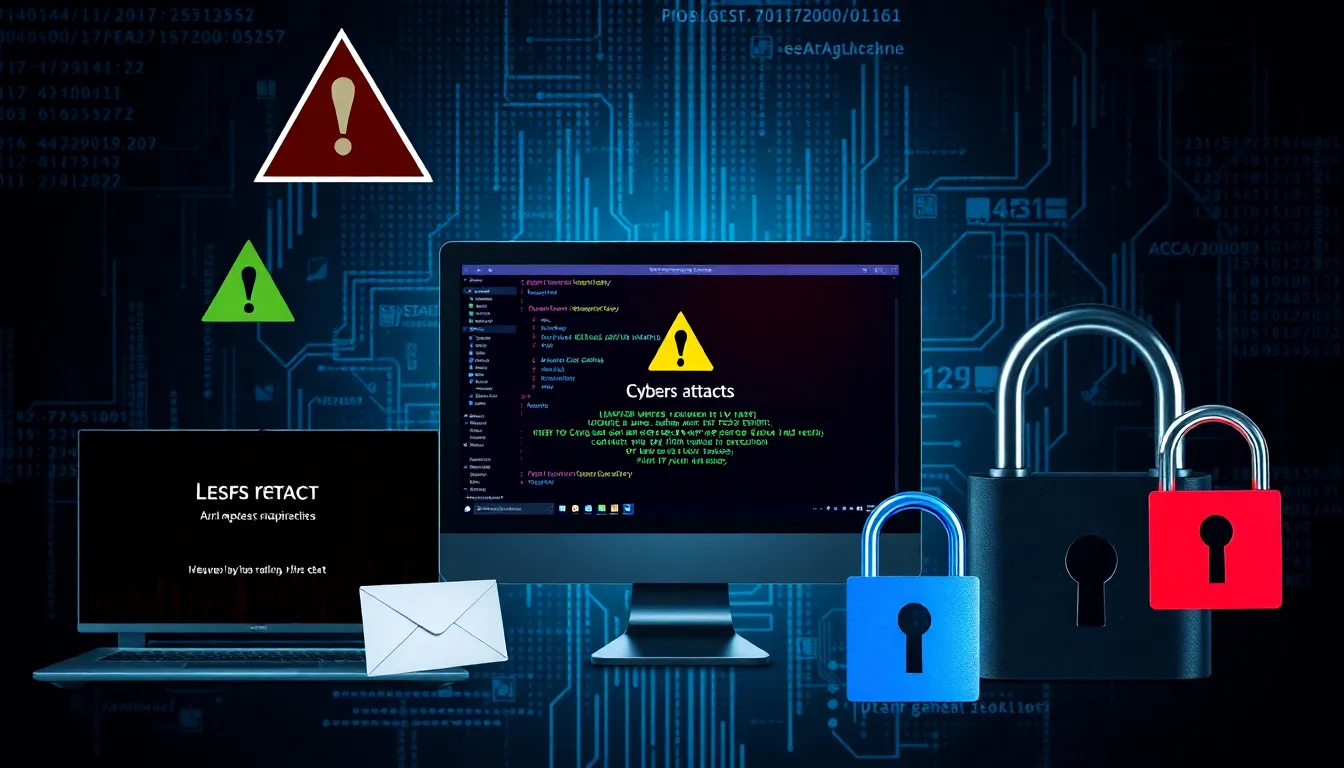In a world where coffee is delivered by drones and smart fridges remind you to buy milk, cyber attacks have become the unwelcome party crashers of the digital age. These sneaky intrusions can turn a normal day into a tech nightmare faster than you can say “malware.” With hackers lurking around every virtual corner, it’s time to take a closer look at how these cyber mischief-makers operate and what they mean for everyday folks.
Picture this: you’re binge-watching your favorite series, and suddenly your screen freezes, followed by a pop-up demanding ransom. Not quite the cliffhanger you were hoping for, right? Understanding the dynamics of cyber attacks isn’t just for IT professionals; it’s crucial for everyone who uses technology. Buckle up as we dive into the wild world of cyber threats and arm you with the knowledge to stay one step ahead of the digital villains.
Table of Contents
ToggleOverview of Cyber Attacks
Cyber attacks encompass a range of malicious activities aimed at compromising the integrity, confidentiality, or availability of systems and data. Various forms include phishing, malware distribution, and denial-of-service attacks. Attackers exploit vulnerabilities in systems, often targeting businesses, governments, or individuals.
Phishing attacks exploit human psychology, tricking victims into sharing sensitive information. Examples include fake emails or websites resembling legitimate entities, leading users to unknowingly disclose passwords or personal data.
Malware acts as a malicious software designed to harm devices or steal information. Types range from viruses to ransomware, where access to data is blocked until a ransom is paid. These threats can infiltrate systems via unpatched software or compromised downloads.
Denial-of-service attacks aim to disrupt services by overwhelming systems with traffic, rendering them unavailable to legitimate users. Organizations experience significant revenue loss and reputational damage when such attacks occur, highlighting the importance of robust cybersecurity measures.
Statistics reveal that in 2022, 43% of businesses experienced cyber attacks. Regular security assessments and employee training enhance defenses against these threats. Cyber security protocols, including firewalls and intrusion detection systems, serve as critical barriers against unauthorized access.
Understanding the various types of cyber attacks aids in recognizing the threat landscape. Organizations equipped with knowledge about these risks can implement effective strategies, ensuring protection against ever-evolving cyber threats. Training employees fosters awareness and preparedness, essential components of a comprehensive cybersecurity strategy.
Types of Cyber Attacks

Various types of cyber attacks pose significant threats to both individuals and organizations. Understanding these tactics enhances awareness and preparedness against potential breaches.
Malware Attacks
Malware attacks involve harmful software designed to infiltrate systems. Common forms include viruses, worms, and Trojans. Each of these can corrupt files, steal data, or disrupt operations. Organizations must regularly update antivirus solutions to combat these threats. Additionally, users should avoid downloading unknown attachments or software. Cybersecurity statistics show malware attacks were responsible for approximately 20% of all data breaches in 2022.
Phishing Attacks
Phishing attacks exploit human psychology through deceptive messages. Emails often appear legitimate, enticing recipients to click on malicious links. This tactic can lead to stolen credentials or sensitive information. Recent studies indicate that 41% of organizations experienced phishing attempts in 2022. Employees require ongoing training to recognize and report these threats. Awareness is crucial as attackers continuously refine their strategies to bypass defenses.
Ransomware Attacks
Ransomware attacks encrypt critical files, rendering them inaccessible until a ransom is paid. These attacks disrupt operations, leading to significant financial repercussions. In 2022, ransomware incidents increased by 15%, affecting both businesses and public institutions. Regular data backups are essential for recovery without succumbing to ransom demands. Effective cybersecurity measures, including network segmentation and employee education, reduce vulnerabilities to such attacks.
Impact of Cyber Attacks
Cyber attacks significantly affect organizations, leading to severe repercussions in various areas. Addressing the financial and reputational dimensions illustrates the magnitude of these threats.
Financial Consequences
Cyber attacks result in substantial financial losses for affected organizations. Statistics indicate that businesses lose an average of $200,000 per cyber incident. Direct costs include recovery expenses, legal fees, and regulatory fines. Additional losses stem from downtime, decreased productivity, and reputational harm, which can deter potential customers. The cumulative effect of these financial ramifications can cripple smaller businesses, with 60% of them shutting down within six months after a severe attack. Investing in robust cybersecurity measures can mitigate these financial risks, safeguarding revenue streams and ensuring financial stability.
Reputational Damage
Reputational damage can linger long after a cyber attack. Consumers often lose trust in brands exposed to breaches, leading to a decline in customer loyalty. Data from 2022 reveals that 70% of customers avoid companies with a known history of cyber breaches. Organizations face challenges in rebuilding their reputation, requiring significant time and resources for recovery. Negative media coverage can elevate the stakes, amplifying customer concerns and attracting scrutiny from regulators. Establishing transparent communication during and after an incident helps organizations rebuild trust and maintain their position in the market.
Prevention and Mitigation Strategies
Effective prevention and mitigation strategies significantly reduce the risk of cyber attacks. These approaches enable organizations to better protect sensitive data and maintain operational integrity.
Cybersecurity Best Practices
Employing strong passwords is a crucial first step in cybersecurity. Regularly updating software and operating systems can eliminate known vulnerabilities. Conducting frequent employee training sessions promotes awareness of phishing and social engineering tactics. Implementing multi-factor authentication adds an additional security layer. Conducting regular security assessments identifies weaknesses before attackers do. Staying informed about emerging threats allows organizations to adapt their defenses. Adopting a clear incident response plan prepares teams to act swiftly during breaches.
Role of Technology and Tools
Utilizing firewalls is essential for controlling incoming and outgoing traffic. Intrusion detection systems help monitor network activity for suspicious behavior. Advanced analytics tools enable organizations to detect anomalies in real-time. Encryption should secure sensitive data both in transit and at rest. Backup solutions must be prioritized to ensure data recovery during an incident. Security Information and Event Management (SIEM) systems aggregate log data for proactive threat analysis. Regular updates of cybersecurity tools keep defenses robust against evolving attacks.
Cyber attacks are a growing concern that can disrupt lives and businesses alike. As technology continues to evolve so do the tactics employed by cybercriminals. Understanding the various types of attacks and their potential impact is crucial for everyone.
Implementing strong cybersecurity measures can significantly mitigate risks. Regular training and updates ensure that individuals and organizations stay one step ahead of threats. By fostering a culture of security awareness and utilizing advanced tools, companies can protect themselves from the devastating effects of cyber incidents.
The digital landscape demands vigilance and preparedness. Taking proactive steps today can safeguard against the uncertainties of tomorrow.




